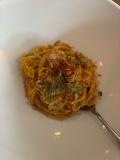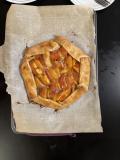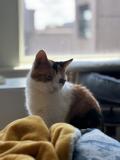Monday, July 15, 2024
By:
There are three more weeks of dragonfly propaganda left. I hope I have done enough propaganda that dragonflies become the most beloved insect. This week? The Southern Hawker, Aeshna cyanea.
The dragonfly body has ten segments (one is near the thorax, ten is at its tail), a thorax, and a head. Descriptors of each segment are used to identify species. The male Southern Hawker has many greenish spots, with blue spots and bands occurring in segments 8 through 10. Female Southern Hawkers only have green spots but have bands in segments 9 and 10. They are large dragonflies, with body lengths of 70 millimetres and wingspans of 110 millimetres. While they breed and have territory near ponds, they often hunt in woodland areas far from water. They are very active fliers.
Four forces affect things that fly: lift, weight, thrust, and drag. Gliding is a type of flight without thrust – there is nothing continually pushing them forward. When things glide, they sink through the air at a rate where they are moving more horizontally than vertically. They only move upwards when they fly through air that is rising faster than the rate they are sinking. Gliding things continuously losing energy to drag. In steady gliding flight, the lift and drag acting on an object balances its weight.
Insects such as dragonflies may glide for a variety of reasons. Migratory dragonfly species are gliders, which may be an energy-saving flight strategy. Gliding dragonflies also move quickly through the air, which lets convection currents cool their bodies without their muscles producing heat. This may help them thermoregulate, maintaining a constant body temperature. The Wandering Glider, Pantala flavescens, can glide at 15 m/s for 10 to 15 seconds. Dragonflies in the Aeshna genus (just like the Southern Hawker!) can glide up to 30 seconds without losing altitude.
Several structural variables influence how efficiently dragonfly species glide: how much weight the wing can carry, the veins and corrugation on the wings, and the body proportions and wing proportions. Dragonflies with disproportionately long abdomens will have higher drag. The veins and corrugation of the wings impact its stiffness and may impact drag and lift. Species that do a lot of gliding have broader wings, and longer wings may increase manoeuvrability. Wing proportions are described with an aspect ratio, a relationship between the length and average width of the wing. High aspect ratios mean there is a high ratio of lift to drag, meaning that the object can fly more efficiently for longer ranges with less drag slowing its forward motion.
Aeshna dragonflies. Ginormous, brown bodies with blue or yellow stripes, fantastic, great gliders.
This week my dragonfly propaganda went to the next level at AAPT. Monday morning, I went to a committee meeting and took notes for Justine, then played with some physics demos at a session titled Make, Do, Play, Learn: Revolutionary Ideas to Teach Physics. I made a little rubber band harmonica. Then, K-12 events, a STEP-UP Nosh and Know, the SPS reception (my team won trivia), and more K-12 events. I got to see Jocelyn Bell Burnell speak on transient space events! Tuesday morning began with another 7:45 committee meeting. Then, I saw my professor’s presentation (Wahoo! Dr Crouch!) and my friend's poster presentation (Go, Nikhil!). I went to the plenary and then took a break in the K-12 lounge (thank god). Post-break, it was lunch and then time for my presentation. I presented in the K-12 lounge about the physics of dragonflies (what else would it be about) and the demos I am including in the SOCK kit. The best part? A group of teachers, Kayla, and Reidyn doing a little dance from the waves demonstration. Hilarious. Afterwards, I realised I had many dollars left from my AAPT food stipend, so I took myself to a fancy pasta dinner. 10/10. The day ended with an evening committee meeting where the Pre-HS committee brainstormed events for the Winter Meeting. Maia as a speaker? Stay tuned! Wednesday was the last AAPT day, and I went to two plenaries, some presentations, and had some lunch. Then, I was off to the airport and back in DC. May Kai be blessed by every god imaginable for having already made dinner when I got home.
Thursday, these two roommates drove into Maryland bright and early. We returned the Astro on the Mall materials (finally), and I sorted through all my SOCK materials packages. I packed some items for SOCK boxes. In the evening, I made a peach tart (delicious), we played Mario Kart (I am not good at it). I took Friday off (thank you, Mikayla), met a college friend for brunch, and then picked my girlfriend up from the train station (wahoo!!!). We went for a walk, and then I put her and Kai to work making dumplings for dinner (delicious). Saturday, we (my girlfriend and I) visited my cousins and got Chinese food, ice cream, cat time (Peebs!!!) and played Trivial Pursuit. Sunday was Planet Word Day (DC’s interactive linguistics museum). The museum was filled with two groups of people: families with children and sapphics. Good stuff. We stopped at a used bookstore on the way home and then made some pasta and cookies to watch the Copa America game.
Summary: Aeshna dragonflies are awesome, conferences are exhausting, the word museum is fantastic, 11/10 weekend, and I am bad at Mario Kart.
Maia Chandler





